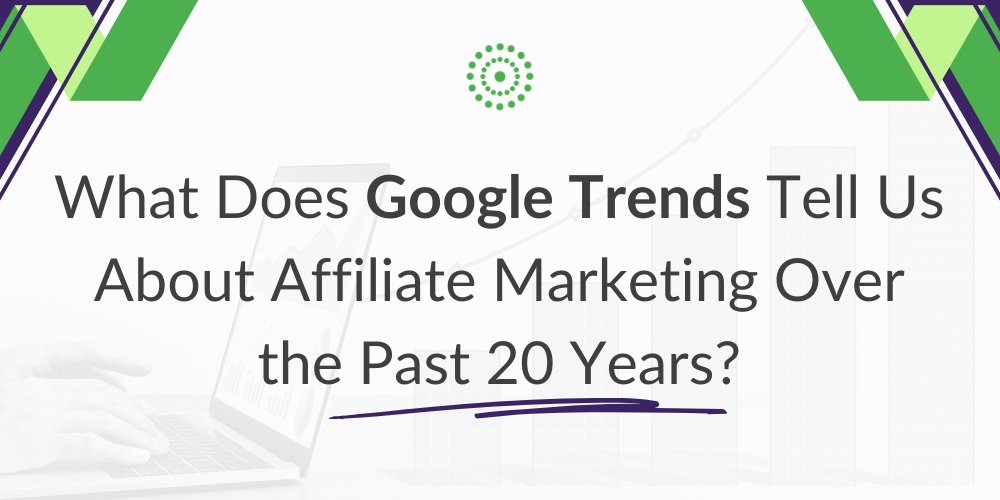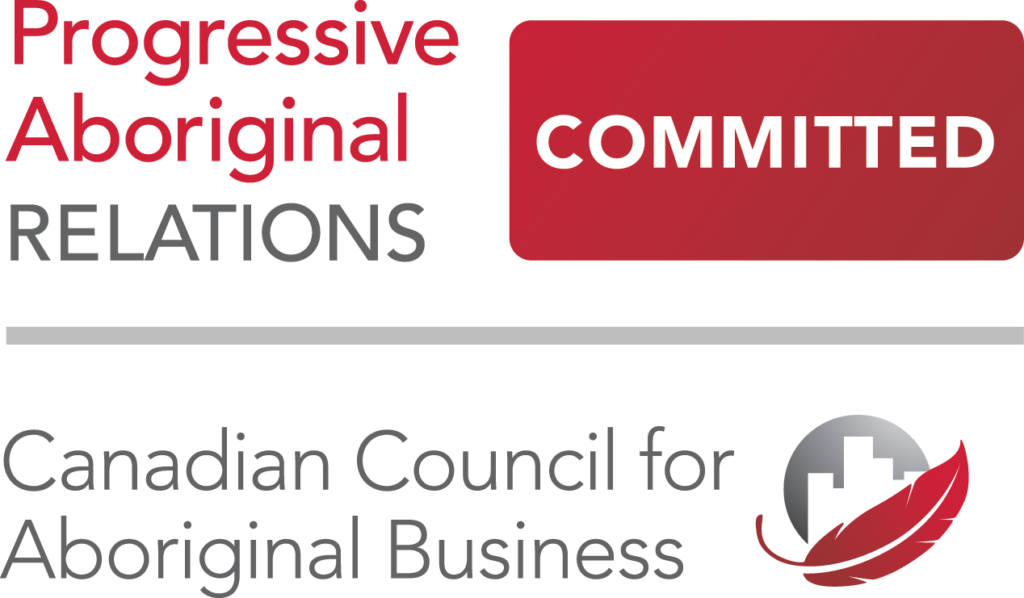When I started in the affiliate marketing industry in 2004, affiliate marketing wasn’t at all well known. It was tiny, had no clear industry leaders or technologies, no associations, no platforms for learning, no compliance requirements, limited partnerships, and very low adaptability by brands.
Since then, affiliate marketing has experienced explosive growth. The expansion of e-commerce, advancements in technology, the introduction of governing bodies, and shifts in consumer behavior fueled this growth.
Let’s embark on a deep dive, examining the intricate patterns and accelerating growth trajectories that have characterized affiliate marketing over the years. By delving into this analysis, we can gain valuable insights to help us better understand where we have come from and where we are going.
A Brief History
- Early Years (2000s): Affiliate marketing began gaining traction in the early 2000s as more businesses recognized its potential for driving sales and leads. Growth during this period was steady but relatively modest compared to later years.
- Mid-2000s to Late 2000s: The mid to late 2000s saw a significant uptick in affiliate marketing activity; driven by the rise of blogging, social media, and niche websites. This period marked a surge in the number of affiliate programs and affiliates participating in them.
- Late 2000s to Early 2010s: The late 2000s and early 2010s witnessed continued growth, with more businesses embracing it as a cost-effective way to acquire customers. The emergence of affiliate networks and the adoption of performance-based advertising further fueled growth during this period.
- 2010s: The 2010s saw explosive growth, propelled by the proliferation of smartphones, the growth of mobile commerce, and the rise of influencer marketing. Affiliate marketing became more sophisticated, with advances in tracking technology and analytics allowing for more precise targeting and measurement of campaigns.
- 2010s to Present: Affiliate marketing continued to grow throughout the latter half of the 2010s and into the 2020s. The industry evolved to include new types of affiliates such as content creators, social media influencers, and mobile app developers. Additionally, the globalization of e-commerce expanded opportunities for affiliate marketers to reach audiences worldwide.
How The Pandemic Further Impacted Growth
The COVID-19 pandemic further expedited the growth of the industry by accelerating existing trends and driving fundamental shifts in consumer behavior. With lockdowns and social distancing measures implemented worldwide, there was a surge in online shopping and digital consumption as consumers sought alternative ways to access goods and services.
This shift towards e-commerce and digital lead generation created new opportunities for affiliate marketers. Businesses turned increasingly to performance-based digital advertising models. These models aimed to reach, engage, and convert their target audiences in a completely new way.
The pandemic also led to the rise of new consumer trends, such as increased demand for home fitness equipment, remote work essentials, software as a service (SaaS), and online entertainment. This created an opportunity for affiliate marketers to capitalize on emerging niches and product categories.
Additionally, the widespread adoption of remote work and social distancing measures forced businesses to rethink their marketing strategies. Thus, leading to greater investment in digital channels and influencer partnerships, further contributing to the growth of affiliate marketing. As a result, the COVID-19 pandemic acted as a catalyst for the rapid expansion and evolution of affiliate marketing; cementing its status as a vital component of the modern digital marketing ecosystem.
Although growth rates may differ based on factors such as region and industry, affiliate marketing has consistently surpassed the growth rates of numerous other digital advertising channels. According to different reports and studies, affiliate marketing expenditure has been growing at an average annual rate of around 10% YoY over the past two decades.
GLOBAL INTEREST IN AFFILIATE MARKETING VS INFLUENCER AND CONTENT MARKETING OVER THE PAST 20 YEARS
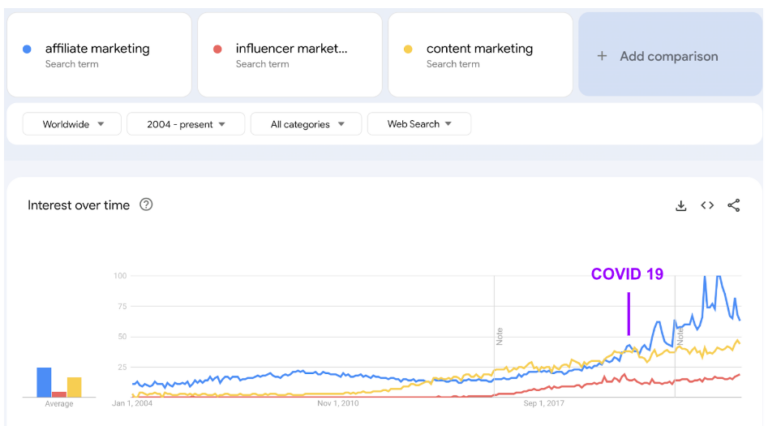
Let’s take a closer look at what’s happened in the past five years using Google Trends. We’ll compare affiliate marketing to influencer and content marketing in the same time period, as an example:
GLOBAL INTEREST IN AFFILIATE MARKETING VS INFLUENCER AND CONTENT MARKETING IN THE PAST 5 YEARS
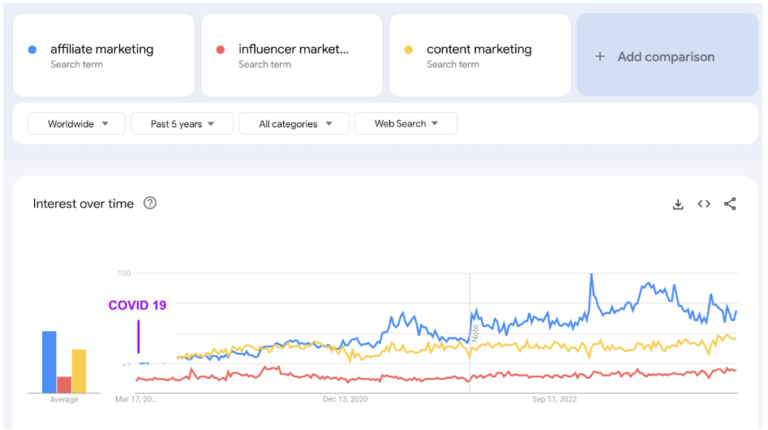
CANADIAN INTEREST IN AFFILIATE MARKETING VS INFLUENCER AND CONTENT MARKETING IN THE PAST 5 YEARS
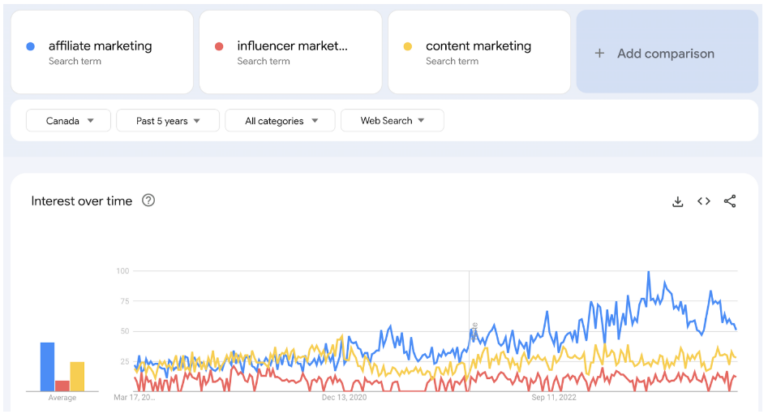
US INTEREST IN AFFILIATE MARKETING VS INFLUENCER AND CONTENT MARKETING IN THE PAST 5 YEARS
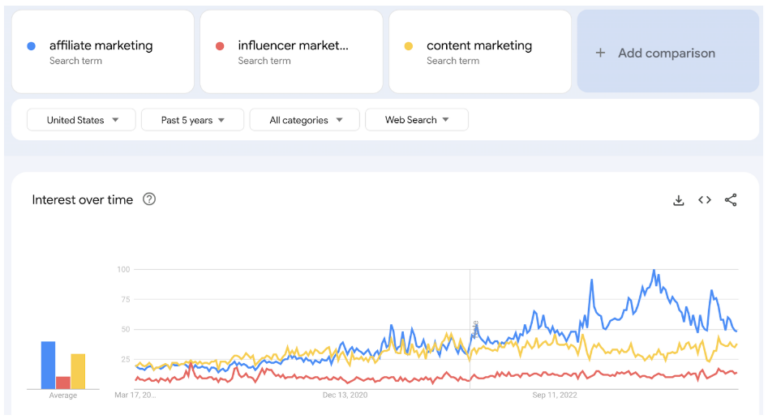
UK INTEREST IN AFFILIATE MARKETING VS INFLUENCER AND CONTENT MARKETING IN THE PAST 5 YEARS
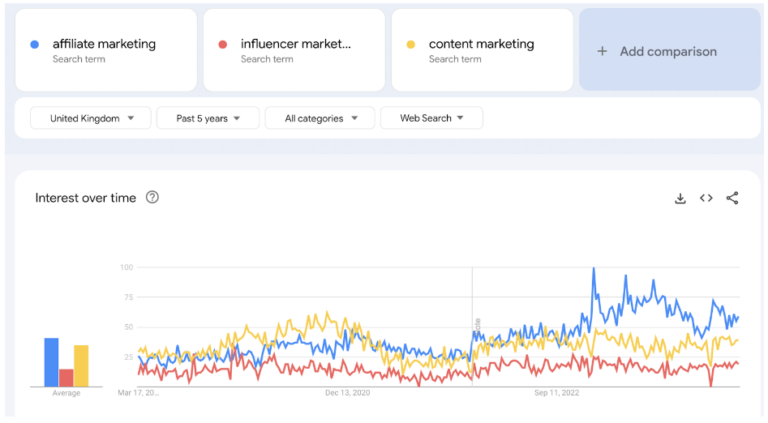
As you can see from the Google Trends screenshots above, affiliate marketing has outperformed both influencer and content marketing over the past five years. According to these reports, it took about a year for brands to figure out affiliate marketing was an intelligent and scalable solution to growth.
Those who adapted and embraced affiliate marketing and performance-based partnerships as part of their growth strategies thrived. When they invested in the channel as a growth strategy, they benefited from expanded reach, new customer acquisitions, and gained market share. Those who remained afraid and undecided saw less growth and limited reach. This resulted in paying more for clicks and attention through channels such as paid social and Google Adwords.
Over the past five years, affiliate marketing in Canada, the United States, and the United Kingdom has undergone significant transformations, reflecting both global trends and regional dynamics. Across various industries in Canada, there has been a discernible increase in the adoption of affiliate marketing strategies. This surge has been driven by the growing importance of digital channels in engaging consumers, spanning from retail brands to Software as a Service (SaaS) companies. This period has witnessed a surge in Canadian affiliate marketers utilizing content creation, social media, and influencer partnerships to effectively showcase products and services.
Advancements in tracking technology and analytics have empowered businesses to refine their affiliate marketing strategies and accurately gauge campaign performance. Meanwhile, in the United States, affiliate marketing has experienced substantial growth and evolution, aligning with integrated trends in digital marketing. All markets have seen a surge in influencer marketing, with social media influencers playing a pivotal role in driving affiliate sales.
Additionally, the emergence of mobile commerce has prompted marketers to create campaigns specifically tailored for mobile devices. They recognize the significance of tapping into the ever-expanding pool of consumers who prefer shopping via smartphones and tablets.
The affiliate marketing landscape has also diversified, with businesses exploring partnerships beyond traditional networks, including collaborations with niche bloggers, podcasters, and YouTube creators. Similarly, in the United Kingdom, affiliate marketing has evolved significantly, with businesses adapting to changing consumer preferences and technological advancements. The UK market has witnessed a rise in influencer marketing in affiliates, mirroring trends seen in other regions. Social media influencers wield growing influence over consumer purchasing decisions. They also explore new avenues of monetizing their content and platforms, including through performance-based partnerships.
Finally, advancements in data analytics, attribution, and personalization have enabled businesses to optimize their affiliate marketing campaigns for better targeting and engagement. Overall, the affiliate marketing landscapes in Canada, the United States, and the United Kingdom as shown above, have evolved in tandem with global trends. All reflecting a shared commitment to innovation and adaptation in the ever-changing digital marketplace.
What’s Next?
Over the next five years, affiliate marketing is poised to continue its trajectory of growth and importance in the digital marketing landscape. With the ongoing expansion of e-commerce, the expansion of digital channels, and the increasing influence of social media, affiliate marketing will remain a vital strategy for businesses.
For digital marketers to adapt to this evolving landscape, prioritizing data-driven insights, leveraging emerging technologies such as AI and machine learning for campaign optimization, and fostering strategic partnerships with a diverse group of partners will be crucial. Digital marketers will also need to stay abreast of regulatory developments and consumer preferences. This will be essential for marketers to effectively navigate this constantly evolving environment. Those who stay on the ball and head of the curve will win. Everyone else will fall behind.
Conclusion
Steady growth, technological advancements, and shifts in consumer behavior have characterized the evolution of affiliate marketing over the past two decades. Looking ahead, affiliate marketing is poised to become a cornerstone of digital marketing growth strategies. This is driven by the continuous expansion of e-commerce and the growing significance of integrated digital channels for consumer engagement. Marketers can gain a competitive edge by embracing data-driven insights, harnessing emerging technologies, and fostering strategic partnerships. These approaches enable them to effectively navigate the evolving affiliate marketing landscape and seize emerging opportunities.


